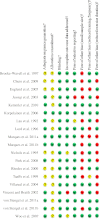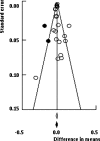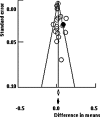Exercise effects on bone mineral density in older adults: a meta-analysis of randomized controlled trials
- PMID: 21922251
- PMCID: PMC3528362
- DOI: 10.1007/s11357-011-9311-8
Exercise effects on bone mineral density in older adults: a meta-analysis of randomized controlled trials
Abstract
The purpose of the study was to assess the effects of exercise interventions with different impact loading characteristics on lumbar spine (LS) and femoral neck (FN) bone mineral density (BMD) in older adults. We searched electronic databases and hand searched selected journals up to February 2011 for randomized controlled trials (RCTs) investigating the effects of impact exercise interventions on LS and FN BMD in older adults. Exercise protocols were categorized according to impact loading characteristics. Weighted mean difference (WMD) meta-analyses were undertaken. Heterogeneity amongst trials and publication bias was tested. Random-effects models were applied. Trial quality assessment was also undertaken. Nineteen RCTs, including 1577 subjects, met the inclusion criteria. Twenty-two study group comparisons reported BMD data at the LS. Meta-analysis showed a significant change in BMD at this site (WMD 0.011 g/cm(2), 95% CI 0.003 to 0.020; p = 0.007), although results were moderately inconsistent (I(2) = 52.2%). BMD data at the FN were available from 19 study group comparisons among older adults. Results were inconsistent (I(2) = 63.6%) in showing a significant positive effect of exercise on BMD at this site (WMD 0.016 g/cm(2), 95% CI 0.005 to 0.027; p = 0.004). Combined loading studies of impact activity mixed with high-magnitude joint reaction force loading through resistance training were effective at LS (WMD 0.016 g/cm(2), 95% CI 0.002 to 0.036; p = 0.028), and no inconsistency existed among these trials. Odd-impact protocols were also effective in increasing BMD at LS (WMD 0.039 g/cm(2), 95% CI 0.002 to 0.075; p = 0.038) and FN (WMD 0.036 g/cm(2), 95% CI 0.012 to 0.061; p = 0.004), although heterogeneity was evident (I(2) = 87.5% and I(2) = 83.5%, respectively). We found consistency among results for low-impact and resistance exercise studies on LS and FN, although non-significant BMD changes were evident amongst these types of protocols at any site and amongst the RCTs that provided a combined loading impact exercise at FN. Funnel plots showed no evidence of publication bias. Trial quality was moderate to high. The findings from our meta-analysis of RCTs support the efficacy of exercise for increasing LS and FN BMD in older adults.
Figures






References
-
- Borenstein M, Hedges LV, Higgins JP, Rothstein HR. Introduction to meta-analysis. Chichester: Wiley; 2009.
Publication types
MeSH terms
LinkOut - more resources
Full Text Sources
Medical
Miscellaneous
